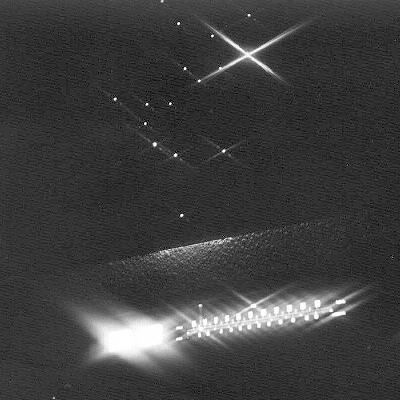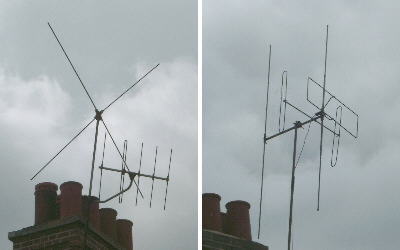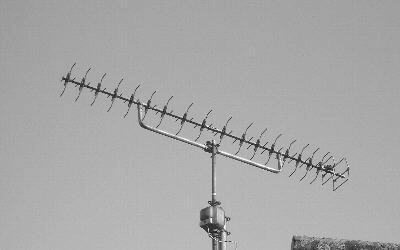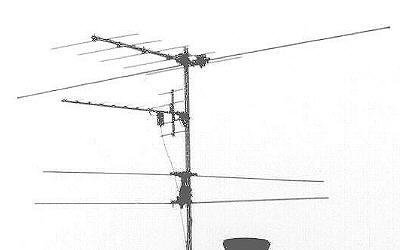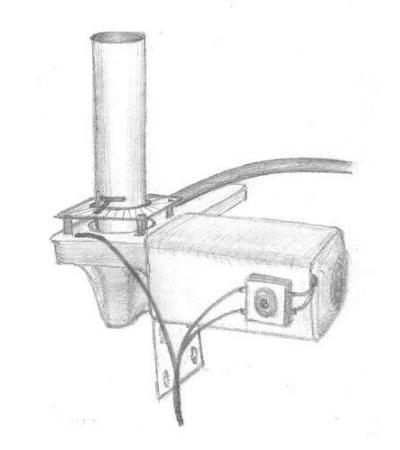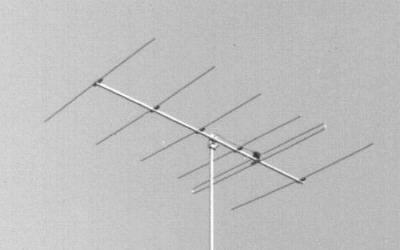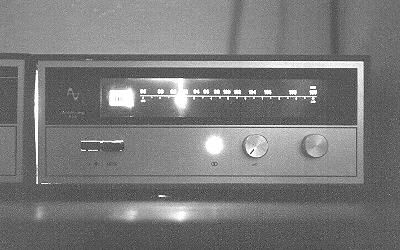----------
|
The Hi-Fi Section - DX-ing |
|
|
In the days before DAB (Digital Audio Broadcasting) Radio, when listeners were still striving for "Quality" rather than "Quantity", DX-ing was a popular pastime of many Hi-Fi enthusiasts. |
|
|
Back in the early / mid' 1970's, "Stereo" radio was still not available in every "Nook and Corner" of Great Britain. This was especially true, here in "Rural" Norfolk, being one of the last areas in Great Britain to have Stereo radio coverage. If you wanted to enjoy the pleasure of such broadcasts, then you would need to receive a signal from a distant (DX) "Stereo" transmitter, rather than that provided by your local "Mono" only transmitter i.e Tacolneston. |
|
|
This would normally require the use of a "High Gain" FM aerial, consisting of at least four elements, coupled to the obligatory "Aerial Rotator". The fragile signal being fed through a "Low Loss" Co-ax cable, into the FM tuner of your dreams. This sort of equipment did not come cheap, and for me, like many others, much DIY was required |
|
|
|
"The Map" and Pioneer TX-9100 Tuner - Cira 1977 |
|
|
|
|
VHF 88-108 MHz |
|
|
During this time, "Local Radio" was only in its infancy, and the VHF 88-108 MHz scale (Band II) was far less cluttered than it is today. The only FM broadcasts to be found, were those from BBC i.e. Radio 2 (Light), 3 (Third), 4 (Home) and maybe a "Local Radio" station. Additionally, if your tuner had poor AM rejection, than you would probably find the local police, transmitting somewhere towards the higher end of the VHF scale, in AM.. |
|
|
Very occasionally, during favorable weather conditions, you might be lucky to find a "Handful" of Western European stations scattered across the scale of your tuner. |
|
|
Note - The first "Local Radio" station, in Great Britain, was "BBC Radio Leicester". Broadcasting commenced in November 1967, via a 50 Watt "Valve" VHF transmitter. This was replaced, in 1971, by a 300 Watt "Transistorized" VHF transmitter. Now 50 years old in November 2017. |
|
|
BBC "Test Tone Transmissions" and Multiplex Stereo Radio |
|
|
During the early 1970's, and very late in the evenings, the BBC transmitted a series of "Test Tones" on Radio 3. These transmissions were designed to help / aid, in the "Setting-up / Alignment" of stereo decoders e.g. Cross-talk adjustment, and for Channel Identification purpose's etc. Information, about these transmissions, was freely available from the "BBC Engineering Information Service" at that time i.e. "Information Sheet 1605(5)" |
|
|
For more information on how FM Multiplex Stereo radio works, please see the excellent article by "Harry Leeming". |
|
|
Various Aerials ..... |
|
|
There were many commercially manufactured Band II aerials available in the 1970's, but the larger arrays were somewhat out of my price range. Therefore, after having read many books and papers on aerial design, I set out to have a go at designing and building my own. |
|
|
The British government was then starting to "Shut Down" the old VHF, 405 Line "Black & White" television transmitters, broadcasting on Band's I and III (See Map and Information). Moving up to the newly allocated UHF channels, for 625 Line "Colour" television broadcasts, on Band's IV and V. |
|
|
Therefore, there would be plenty of material, from the copious amount of old redundant aerials, available for DIY Band II aerial construction. |
|
|
See "Various Aerial's" used for Band I, through to Band V, Television and Radio reception. Together with an "Old Advert" dating back from 1957. |
|
|
|
A "Selection" of Band I and III aerials (Larger View) |
|
Yet Again ! |
|
|
Whilst on the subject of television broadcasting ..... as of the old VHF, 405 Line "Black & White" television broadcasts, then the current UHF, 625 Line "Colour" television broadcasts are due to be "Phased Out". With the first transmissions "Shutting Down" in 2008, with completion by 2012. The old UHF service will be replaced with, wait for it ..... DTV (Digital TeleVision). This time making all of the "Older", pre SCART connector, Band IV / V Television receivers and Video recorders redundant ..... ! |
|
|
Provided that the signal strength was adequate, then the picture quality obtained "Off Air" via UHF broadcasts, was very good indeed. Without any of the problems that we find with Digital Broadcasts. |
|
|
I sometimes wonder if change is really necessary ? |
|
|
My apologies for deviating from Hi-Fi / Band II aerials. |
"High Gain" Band V aerial and Rotator (Larger View) |
|
|
|
|
DIY "Band II" Aerial's |
|
|
DIY designs were normally constructed from the "Recovered" elements, obtained from old "Band I" television aerials i.e. due to their larger physical dimensions. With the Boom / Spine of the old "Band III" aerials, being used to support the "New" elements. All the old material being cleaned and cut to size, then used in the construction of Band II aerial designs. |
|
|
Starting with a very simple 2-element i.e. Dipole and Reflector design, mounted on the chimney bracket together with existing VHF and UHF television aerials. |
|
|
Finally building a 6-element Band II aerial i.e. Dipole, Reflector and Four Director elements, for "Extra Gain". The DIY 6-element aerial was fitted in the loft space. |
|
| Much better ..... I now required a suitable rotator ! | |
|
|
DIY 2-element "Band II" aerial, below TV aerials |
|
Austin Cambridge A55, Connection |
|
|
I used a suitably geared, electric motor for the aerial rotator. Being that of a "Window Wiper" motor assembly, recovered from my late fathers old "Austin Cambridge A55" motor car. |
|
|
The "Series" connected wiper motor, would only run in one direction i.e. "Clockwise", irrespective of the polarity of the DC power supply (12 Volts, at 2 Amps "Full Load"). However, after fitting a bridge rectifier "Around" the field winding, the motor would run both "Clockwise" and "Anti-clockwise", as required. |
|
|
The output speed was still quite fast, so the unit was feed on "Pulsed DC", thus slowing the unit down considerably. High value capacitors were fitted across the armature and field windings, to help reduce the vibration problems that are associated with such a supply. |
|
|
A suitable section of "Short Pole", was welded to the output drive of the motors gearbox. Thus allowing the aerial to be physically attached to the "Rotator". |
|
|
Electrical "End Stops" were fitted to the "Rotator", in the form of "Micro" switches wired in series with the motor. To allow the motor to be reversed, a "By-pass" diode was fitted in parallel with each of the two "End Stop" switches. |
|
|
|
Original sketch of DIY "Aerial Rotator" |
|
"The Map" |
|
|
The aerial and rotator combination worked very well. However, I was totally oblivious to what direction the aerial was pointing. Some form of direction indicator would be required ! |
|
|
I found a map of Europe and glued it to a suitably sized piece of Hardboard. The map was to become a suitable "Feature" on the wall above the Hi-Fi. Then, by using a piece of copper clad PCB, I constructed a rotary switch. This would be fixed around the output shaft of the rotator. My own physical location on the map, being the centre axis of the switch, and the contacts, being the direction of the desired transmitter stations. |
|
|
Each transmitter station being represented by a "Bi-coloured" lamp on the map i.e. "White" state, to indicate the location of all the transmitter stations, changing to a "Red" state, to indicate the aerial was pointing towards that particular transmitter station. An adjustable "Wiper" contact, being fitted to the output shaft of the rotator, allowing for system calibration. |
|
|
Using a "Duplicate" switch on the rotator controller, and a few relays, the system was "Automated". Whereby, you simply selected the desired transmitter station, via the rotary switch, and the aerial would "Automatically" stop, when it faced the selected transmitter station. |
|
|
|
"Transmitter Station" site Map - Circ 1976 |
|
From DIY to the "Real Thing" ! |
|
|
Alas, 100% success from my DIY aerial designs was rare, and not so rewarding for all the effort involved. However, having said that, the designs served me very well for the years that I used / relied on them. |
|
|
To obtain better signals i.e. "More Strength", then I would need to purchase a suitable aerial, built for the task. |
|
|
I decided on a "Six" element aerial (JAYBEAM "Stereobeam" SBM6). This had a good "Forward Gain", 8.5dB, and not physically too large. Initially, the aerial was situated in the excellent sized loft space available, together with the "Home-made" rotator unit. |
|
|
At a later date, the aerial taken out of the loft space and mounted on the chimney stack. Alas, the aerial would not be attached to the DIY Rotator unit, as it was far too heavy and definitely not weather proof !!! |
|
|
The DIY aerial rotator, was eventually replaced with a commercial unit i.e. "Stolle" 2010, which is still in excellent working condition. The "Stolle" 2010 rotator, together with the associated remote control unit, worked very well with the SBM6 and later with a "High Gain" Band V UHF TV aerial. |
|
|
|
JAYBEAM "Stereobeam" SBM6 - Cira 1978 |
|
Tuner |
|
|
My original Tuner, being the excellent Armstrong 524 FM tuner, with the "Optional" M8 Stereo decoder board fitted. This gave very good service for many years, and is still in use today, by it's current owner. |
|
|
The Armstrong 524 FM tuner was replaced by a Pioneer TX-9100 unit. The later having excellent "Sensitivity / Signal to noise ratio" and ideal for the task of DX-ing. |
|
|
Many happy hours were spent, searching out alternative programme material etc, using the Pioneer TX-9100. Indeed, there was precious little in the way of Stereo broadcasts in the Norfolk area, at that time, to listen to in any case. |
|
|
Looking back, I always will remember the Armstrong 524 sounding far better, more natural, than the Pioneer TX-9100. |
|
|
|
Armstrong 524, FM only tuner |
|
A fellow local Hi-Fi enthusiast, circa late 1970's, had a wonderful system for DX-ing. Consisting of a "Nine" element aerial, with a "Stolle" aerial rotator, coupled to a "State of the Art" Trio KT-8005 tuner. |

|
|
I had always been impressed with the Trio KT-8005 tuner, both in terms of Audio Quality and it's excellent RF Sensitivity, but I had never found one suitably "Discounted". However, in the middle of the 1980's I acquired a second-hand Trio KT-8005 tuner, for just £15. It is still in current daily use in my workshop. |
|
| Trio KT-8005 tuner on workshop shelf | |
|
Being a valve fanatic, the Leak "Stereo Trough Line III" is probably one of the best designs that I have ever had the pleasure of listening to and owning. Alas, in the late 1980's, I swapped it for a Pair of Leak TL12 plus valve power amplifiers. A course of action, that I deeply regret ! |
|
|
|
|
| What of the future ? | |
|
Just like the old VHF, 405 Line "Black & White" television broadcasts of the past, the "Great" British government is now preparing to "Shut Down" the "Excellent" VHF FM Radio broadcasts on Band II (Also shutting down AM broadcasts). Thus making all of our treasured Leak / Quad etc, AM/FM Radio equipment redundant (re UK Broadcasts). |
|
|
So, as excellent as the VHF FM broadcasts are (2009), by 2015 they will cease to be ..... Gone forever. |
|
|
Well thanks for that ..... us Hi-Fi enthusiasts, and many others, will find that really useful ! |
|
|
As for the future of "High Quality" Radio Broadcasts ..... it would appear that DAB (Digital Audio Broadcasting) is the only way ahead at present. |
|
|
Yes, I admit that there are some advantages with DAB, but with the "Current" audio quality being only slightly better than that of MP3 ..... what can I say. As is so typical in this "Digital Crazy" era, we appear to be sliding backwards, rather than moving forwards ..... Oh lucky us !!! |
|
|
|
|
|
Up-date - In 2016, British radio stations are still broadcasting on VHF FM. |
|
| Plus (or is it minus) ... Not Eco friendly etc ..... | |
|
In the current way of thinking, this "Plan" is far from being eco friendly, as ALL perfectly good AM/FM radios/tuners will be redundant i.e. USELESS. Therefore, they will most likely be "Bagged-up" and sent off to help fill-up yet more landfill sites. Such a waste of equipment and money when the current broadcasting system is a perfectly good one ! |
|
|
Again, I have the need to deviate here, as my own feelings on the matter are so strong In my opinion, the reasons for the "Shut down" are more political ones, rather than those due to improvements in technology. Alas, the "Shut down" of AM/FM radio broadcasting in Great Britain will certainly generate huge sales of DAB radios/tuners, but in terms of business and trade, I cannot see how this will financially help Great Britain, as the majority of these units are imported from overseas. The "Shut down", is yet again something the people of Great Britain have not asked for, but something they are forced to accept. We are suppose to be living in a democratic society ..... or are we ? |
|
|
- - - - - - - - - - - - - - - - - - - - - - - - - - - - - - - - - - - - - - - - |
|
